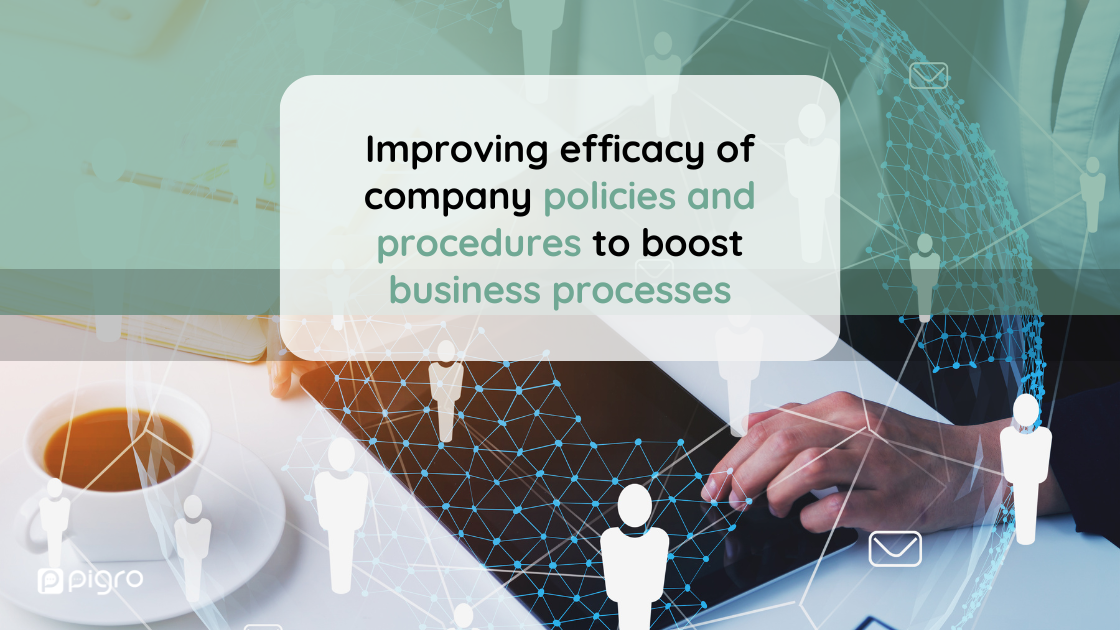For a company to be organized it is necessary to have shared procedures, which describe all business activities, with the roles, tasks and objectives expected, so that all employees can be able to do the job.
Access Pigro Knowledge Insights to discover how to improve the consistency of your company procedures! Or keep reading to learn more.
Why is business process documentation important?
Each time an employee carries out a job he uses information and creates new knowledge, which increases the amount of company know-how. But where is this knowledge recorded? Is it shared in the right way? And what should it include to be effective for the company?
To answer these questions it is useful to build guidelines, rules, and quality standards, which can be adopted whenever information is created or shared within the company. In a nutshell: you need to document business procedures.
But what is process documentation and which are types of business documents? This may include company policy and procedures manuals, best practices documents, operating instructions and training modules, all of which provide a reference for the company’s employees to perform tasks consistently and accurately.
To document business processes effectively, you need to know that what makes good process documentation is the fact that every employee uses it to understand exactly what to do and how to do it, thus reducing errors, waste of resources and time needed to train new employees.
It also helps ensure legal and regulatory compliance by providing a track record of activities carried out within the company.
Roles and risks related to business process management
When it comes to analysing and mapping business processes, you can’t trust anyone with the delicate task of describing related procedures.
This is because you must first have access to the necessary information, and, last but not least, you have to know the priorities and needs of the teams to write best practice guidelines and choose what should be included in process documentation.
The risk is, in fact, to produce useless documentation, containing vague or inconsistent information, without well-defined objectives, that uses inappropriate terminology or that is not accessible for training and formation purposes.
The task of the Human Resources division is to train employees, providing them with both theoretical knowledge and practical methods, necessary to carry out the work and achieve goals.
In order for this to happen, it is also necessary to have access to knowledge and the various company tools, a task that can be facilitated by the presence of a Knowledge Manager.
This figure deals with identifying, collecting, organising and managing the information acquired by the organisation to support the different business units.
The Knowledge Manager must also ensure that all processes and structures through which knowledge is recorded and shared are built.

In addition to the choice of a competent person to draw up policies and procedures of a company, a number of methods can be applied to create clear, exhaustive and correct documents.
However, unless your organisation is small or newly formed, documentation on work procedures often already exists.
At this point, it is, therefore, necessary to manage the company documentation and keep it up-to-date to support decisions and document the quality standards of production.
But it’s not always easy to keep track of your knowledge base and get KPIs on how content is used. Just as it is not always possible to monitor the update status of the information and the possible presence of data silos - or data collections held by a group or department and, therefore, not easily accessible to other business teams.
How to support access and knowledge sharing in the enterprise by improving business process documentation
To achieve, therefore, a real optimization of business processes and information systems related to them, it is necessary to start from the analysis and monitoring of the knowledge base.
In fact, it contains all the documents that the company has already produced to describe guidelines and procedures of all kinds.
But when the knowledge base is chaotic and disorganised, or even just very large, it’s even more challenging to keep it under control.
For this, Pigro has developed a feature that allows you to automatically analyse the content of all the company repositories, to measure its quality and understand how to solve any problems.
With Knowledge Insights, you can get a customized report that provides a set of indicators on the efficiency of your knowledge base.
In the previous articles, we have already analysed some examples of actionable insights that can support content optimization for the Sales & Marketing divisions, as well as the Help Desk and Customer Support.
But also to organize a process document (such as company procedures and standards, guidelines, best practices or protocols) you can receive specific suggestions on how to improve it and, above all, on how to strengthen it.
Here are two examples:
- Content redundancy - Pigro provides a list of all documents with redundancy issues, such as duplicate files, different versions of the same document, and groups of files that are similar to each other.
Thanks to this parameter it is possible to clean up your archives, eliminating all the obsolete contents, in order to avoid the presence of conflicting information.
- Incoherent knowledge - Pigro automatically identifies all documents that may not be related to the knowledge base. It also provides a list of files that contain topics not covered in a specific repository.
With this information, you can then decide to move all files to an archive more consistent with those topics, or to increase the presence of content on a given topic.
Only by understanding the quality and problems related to your knowledge base will be possible to increase content effectiveness and unlock the power of business process improvement, to spread value in the entire organisation.
Read also: How can AI boost employee engagement?
Measure the quality of your knowledge base and access the Knowledge Insights from Pigro: start now!
Fill in the form to receive an email with the next steps to connect your repository and the NDA for your documentation.



